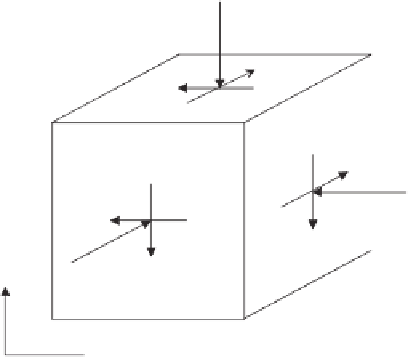Environmental Engineering Reference
In-Depth Information
s
y
−
u
w
s
y
−
u
a
t
yz
t
yz
t
yx
t
yx
t
xz
t
xz
s
y
−
u
a
s
y
−
u
w
t
zx
t
zx
t
xy
t
xy
t
zy
t
zy
s
y
u
w
−
y
y
s
y
−
u
a
x
x
z
z
Figure 3.9
Stress state at point based on surface tractions
extracted from soil structure force equilibrium equations for dry
soil (i.e.,
x-, y-,
and
z-
directions).
Figure 3.8
Stress state at a point based on the surface tractions
extracted from the soil structure force equilibrium equations for a
saturated soil (i.e.,
x-, y-,
and
z-
directions).
It is interesting to note that no area correction appears in
the stress tensor when the analysis is performed in a manner
consistent with multiphase continuum mechanics principles.
3.3.8 Other Combinations of Stress State Variables
The soil structure equilibrium equations can have three dif-
ferent forms depending upon the reference phase used during
the derivation of the equilibrium equations. Equation 3.17
is the result of using the air phase as the reference phase
during the derivation. Other forms of the derivation can use
the water phase or else the total stress field as the reference.
Each form of the equilibrium equations contains a combi-
nation of two stress state variables. In other words, any two
of three possible stress variables (i.e.,
σ
3.3.10 Case of Dry Soil (Solids and Air)
As a soil becomes extremely dry, a change in soil suction
may no longer produce significant changes in mechanical
properties. However, soil suction remains as a stress state
variable even if it is not required to describe the behavior of
the dry soil. The first stress tensor with
σ
u
a
will have the
most significant influence on the shear strength and volume
change of the dry soil. The stress tensor for a dry soil can
be written as
⎡
−
−
u
a
,
σ
−
u
w
, and
u
a
−
u
w
) can be used to describe the stress state for the soil
structure and contractile skin in an unsaturated soil.
⎤
3.3.9 Saturated Soils as Special Case
of Unsaturated Soils
A saturated soil can be viewed as a two-phase system. The
equilibrium equations for the soil structure (i.e., the arrange-
ment of soil solids) of a saturated soil can be derived in the
manner described above. Equilibrium equations can be writ-
ten for the water phase and the overall total stress field. The
equilibrium equation for the soil solids will be the difference
between the total or overall stress field and the water phase
stress field. The extraction of the surface tractions from the
resulting equilibrium equations gives rise to the following
stress tensor containing effective stress variables which can
be placed on a cube to represent the stress state at a point
(Fig. 3.8):
σ
x
−
u
a
τ
yx
τ
zx
⎣
⎦
τ
xy
σ
y
−
u
a
τ
zy
(3.25)
τ
xz
τ
yz
σ
z
−
u
a
The stress state at a point in a dry soil is illustrated in
Fig. 3.9. There are some physical processes where it is nec-
essary to consider soil suction as a stress state variable when
there is a change from the completely dry state (e.g., volume
increase or swelling).
3.3.11 Smooth Transition from Saturated
to Unsaturated Conditions
There is a smooth transition between the stress state for a
saturated soil and the stress state required for an unsaturated
soil. As a soil approaches saturation, the pore-water pressure
u
w
approaches the pore-air pressure
u
a
and the matric suc-
tion term
u
a
−
⎡
⎤
σ
x
−
u
w
τ
yx
τ
zx
⎣
⎦
τ
xy
σ
y
−
u
w
τ
zy
(3.24)
u
w
goes toward zero. In other words, the
second stress tensor (i.e., the soil suction tensor) disappears
τ
xz
τ
yz
σ
z
−
u
w












Search WWH ::

Custom Search